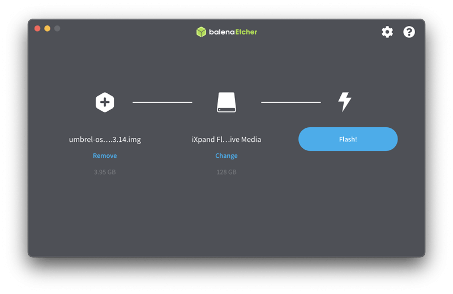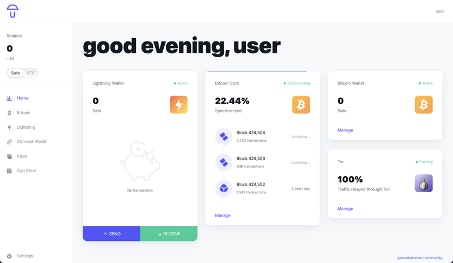This is how you set up your own Bitcoin full node
If you want to communicate directly with the Bitcoin network without going through third-party providers, you can find out in our guide how to set up your own Bitcoin full node.
Bitcoin.org formulates the purpose of a full node as follows: “A full node is a program that fully validates transactions and blocks. Full nodes also help the network by accepting transactions and blocks from other full nodes, validating these transactions and blocks and then forwarding them to other full nodes. ”
Full nodes are primarily validators that contribute to the decentralization of the Bitcoin network. Operating your own full node has the advantage of having its own network node that can be used to send your own transactions: communicate directly with the Bitcoin network without detours via third-party providers. Numerous software and hardware wallets can be configured so that your own full node is used as the provider instead of the full node of a provider.
Contents
Requirements for a Bitcoin full node
“Full Node” sounds powerful and complex – but it isn’t at all. At this year’s The-B-WordAt the conference, Elon Musk said: “The reality is this: The average person will not operate their own Bitcoin node.” Musk can be wrong too.
Since a Bitcoin full node has nothing to do with Bitcoin mining, one is sufficient Raspberry Pi with its computing power. In addition, a specific SSD hard drive for mirroring the blockchain – and the rough hardware setup is ready. In order to tackle the software-based installation of the full node entirely without command line tools, comes Umbrel used as a free and open source application. Thanks to Umbrel, a Bitcoin full node can be set up in a few minutes. Umbrel describes the installation process in great detail on its own website. This makes it very easy for the user to carry out the installation step by step.
Hardware components that Umbrel requires:
• Raspberry Pi 4 with eight gigabytes of RAM
• one terabyte SSD hard drive
• USB 3.0 to SSD adapter
• 16 or more gigabytes of micro SD
• Original Raspberry Pi power supply
• Internet cable
The hardware required for a Bitcoin full node. (Photo: Sergej Müller)
Some notes on setup:
- The current size of the Bitcoin blockchain is 404 gigabytes. In order to prepare the hard drive for the future growth of data, the SSD capacity is one terabyte.
- Be careful when choosing the hard drive and adapter: Umbrel only supports certain hard drives or adapters – we have successfully put the whole thing into operation Crucial MX500 and Inateck USB 3.0 to SATA adapter.
- Do not format the SSD!
- The power supply should be the official Raspberry Pi USB-C power supply. Third-party power supplies can lead to problems in individual cases because not enough power is supplied for the external hard drive.
- The micro SD card should be purchased with an adapter in order to be able to write to the card on a PC with Umbrel OS.
Installation of the Bitcoin full node
Umbrel OS installation
-
- On PC / Mac / Linux the last one Release Download from Umbrel OS (umbrel-os-v0.x.xx.zip) to the computer hard drive (not the SSD of the full node).
- To install Umbrel OS on the micro SD card, Balena Etcher needed. Please download for the respective operating system.
- Insert the micro SD card (using an adapter) into the computer (not Raspberry Pi).
- Open Balena Etcher, select Zip with Umbrel OS, flash.

Flashing Umbrel OS with Balena Etcher. (Screenshot: Sergej Müller)
Setup Raspberry Pi
5. Insert the micro SD card with Umbrel OS into the Raspberry Pi.
6. Connect the external SSD hard drive to the Raspberry Pi using the “SATA to USB 3.0” adapter.
7. Connect the Raspberry Pi to the internet router.
8. Supply the Raspberry Pi with power.
9. 🎉 🎉 🎉
And that’s all. After a few minutes, the full node should be in the home network via http: //umbrel.local be available. Alternatively, via an IP address assigned by the router.
After a successful setup, Umbrel starts synchronizing the blockchain. This means that all blocks since the beginning are validated by the full node. This can take several days. As soon as the blockchain is fully mirrored locally, the full node begins to validate new blocks. Welcome to the network, Validator.

Synchronization of the Bitcoin blockchain. (Screenshot: Sergej Müller)
Can I earn money with a Bitcoin full node?
No. A Raspberry Pi is not suitable for Bitcoin mining.
How much electricity does a Bitcoin full node consume?
A Raspberry Pi 4 as a Bitcoin full node has a power consumption of around 6.6 watts, which corresponds to around 18 euros per year.
Thanks to Umbrel, commissioning a Bitcoin full node is very easy and can be carried out in just a few clicks. In addition, you get your own Bitcoin wallet, Tor support, access to the Lightning Network and numerous apps that Umbrel includes in the scope of delivery.



